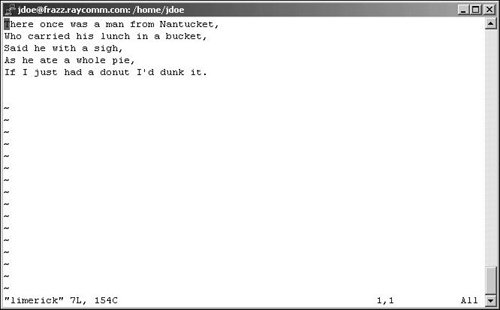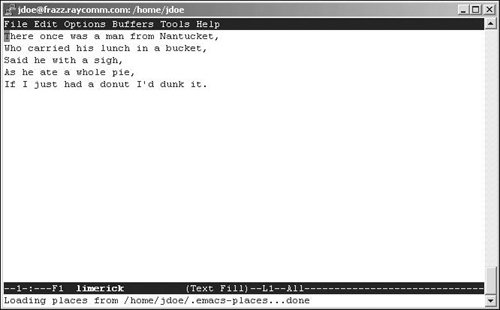Choosing an Editor
| Basically, all editors are designed to do the same things: enable you to create, modify, and save text files. These files could include configuration files, email messages, or shell scriptsessentially any text file you can create. Exactly which editor you choose is up to you, depending on your specific needs and how much you're willing to learn. In this book, we'll stick to three biggiespico, vi, and emacswhich will likely give you all the capabilities you'll need. We chose these because pico is (arguably) the easiest Unix editor to use, vi is one of the most powerful and is available on almost every Unix system, and emacs provides an unbelievable number of options and is a handy tool for the up-and-coming Unix pro to have. About picopico is one of the more straightforward Unix editors and has become quite popular because it's extremely easy to use. In particular, as shown in Figure 4.1, it's menu-driven and intuitive. All of the commands are visible, and you can open, modify, and close files with little effort. pico is a great choice if you're just getting started with Unix or if you won't be needing an editor able to leap tall files in a single bound. Figure 4.1. pico offers onscreen command reminders to make it easier to use. pico is distributed with the pine email program, so if you have pine available to you, you likely also have pico. (See Chapter 1 for a reminder on how to find out if pine and pico are available to you.) If pico is not available to you, ask your system administrator to install it.
About viAlthough vi is likely responsible for much of Unix's reputation for being complicated and confusing, it offers enormous power and flexibilityit will leap tall files in a single bound and do much, much more. Plus, vi is universally available (unlike pico), so for these two reasons, you should consider taking the time to learn it. You might find vi cryptic, counterintuitive, and nitpicky, and for this reason, you might want to choose a different editor if you won't require vi's capabilities. As Figure 4.2 shows, if you use vi, you won't have menus at your disposalyou'll have to get used to using commands like Figure 4.2. vi gives you a clean screen and makes you remember all of its cryptic commands. About emacsWith emacs, you start to understand how incredibly customizable Unix can be. It can be "just" an editoralthough a very powerful one with all kinds of helpful featuresor it can be an email program, file manager, or darn near anything else. We're going to stick to just the editorial functions, but if you find that you like emacs, don't hesitate to explore the Web for other options and features of this editor. Figure 4.3 shows you what to expect from emacs, including the handy (and fairly familiar) menus. Figure 4.3. emacs provides both menus and power, all at once.
|
EAN: 2147483647
Pages: 251
 Tips
Tips